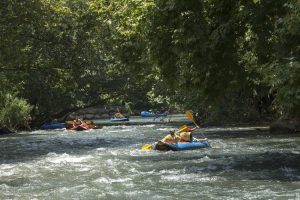
by: By Kathy DeGagne, BFP Staff Writer

Jordan River entering the Sea of Galilee (Photo: Todd Bolen/bibleplaces.com)
The weighty mantle of mystique rests heavily on Israel’s main river, the Jordan. In fact, everything about the Jordan River is on a legendary scale—except its actual size. Even at its deepest and widest, it’s surprisingly small (averaging 2m [6.5 ft] deep and 10m [32.8 ft] wide), considering its historical, economic and spiritual import to the Holy Land and beyond.
The Jordan River’s iconic stature begins in the Bible where it is mentioned numerous times—mainly in connection with miracles. It was here that the tribes of Israel crossed over into the Promised Land on dry ground when the water stopped flowing upriver (Josh. 3:14–17). The prophets Elijah and Elisha also crossed the Jordan on dry land (2 Kings 2:8–14). The Syrian general Naaman was healed of leprosy when he washed in the river (2 Kings 5:1–14). It was also the place where John baptized Jesus, and a voice from heaven spoke saying, “This is My beloved Son, in whom I am well pleased” (Matt. 3:13–17).
From its source at the base of Mount Hermon on the Syrian-Lebanese-Israeli border, the Jordan dances and flows in a convoluted journey down the Jordan Valley to the Sea of Galilee and from there to the Dead Sea. Its Hebrew name “Yarden” means “Dan flows down,” the Dan River being one of its principal tributaries in the north. It does indeed flow down—dramatically—dropping a total of 950 meters [3,117 ft] through its 360-kilometer [224-mi] passage from source to destination, and is the world’s lowest waterway. Beneath the river lies the Great Syrian-African Rift, a tectonic plate fault line running through the center of Israel.

(Photo: Itimar Grinberg/Goisrael.com)
As it makes its journey from the Northern Galilee southward, the river changes drastically from a fast-flowing freshwater source used for drinking and water recreation to a shallow trickling stream in the lower Jordan, clogged with sewage, industrial waste and agricultural runoff. The most polluted portion is the 100-kilometer [62-mi] stretch of river below the Sea of Galilee.
The water usage of the Jordan River basin is shared by Israel, Syria, Lebanon and Jordan, all of whom are responsible for the diversion of 90% of the Jordan’s water. In 1964 Israel started diverting water to its national water carrier; Jordan diverted water from the Yarmouk, a main tributary; and Syria, not to be outdone, also built reservoirs to harvest the waters of the Yarmouk. The diversions have impeded the river’s natural ability to replenish itself with fresh free-flowing water. In 2007, the World Monuments Fund listed the lower Jordan in the top 100 most “endangered cultural heritage sites.”
According to former Israeli Prime Minister Ariel Sharon, the diversion of water from the Jordan River was one of the prime motivators for the Six Day War between Israel and its neighbors. In 1965, Syria, in cooperation with Jordan and Lebanon, attempted to divert the Jordan, threatening to drastically reduce Israel’s water supply. In April 1967 Israel launched air raids to stop the diversion projects. Sharon said, “People generally regard June 5, 1967 as the day the Six Day War began. That is the official date, but in reality it started 2½ years earlier on the day Israel decided to act against the diversion of the Jordan River.”

Baptism at Qasar-al-Yahud (Photo: IDF/wikipedia.org)
Yardenit, the present-day site commemorating Jesus’ baptism, is located north of the Alumot dam so the water quality is good; but for Christian pilgrims who came to the Jordan to be baptized at the lower Jordan site of Qasar-al-Yahud, promoted as the actual site of Jesus’ baptism, water quality was a major concern and health hazard.
Responding to this environmental crisis, Israel and Jordan have come together to try and rehabilitate the Jordan River basin. The Jordan River is the natural common border between both nations. In 2013, Israel released much-needed water from the Sea of Galilee into the river after being stopped up for 49 years. Eight years of extreme drought also caused an extra burden on the water levels of the Sea of Galilee and the Jordan. The riverbed was cleaned and the river water was treated to remove effluent and reduce salinity. The river water improved considerably, and bi-weekly monitoring by Israeli health authorities made sure the water was safe for baptisms, even during spring flooding.
In June 2015, EcoPeace Middle East, an organization dedicated to bringing Jordanian, Palestinian and Israeli environmentalists together, implemented a regional master plan to restore the lower Jordan River and stimulate tourism. Proper sewage treatment plants and agricultural efficiency programs were established by the Jordanians and Palestinians, with Jordan also promising to stop wastewater dumping from their cities.
For Israel’s part, sewage treatment facilities, desalination plants, water purification and wastewater reuse facilities ensured the Jordan would not receive any more industrial or agricultural effluent. Fishpond runoff would be diverted for agricultural use, and freshwater flow from the Sea of Galilee would be increased to help dilute contamination. Fifteen thousand anti-personnel and anti-tank mines, buried by the Jordanians and Syrians during the Six Day War, were also cleared from the riverbanks.
The legendary lower Jordan, once dead, now has the chance to live again. The river is cleaner than it has been in 50 years, with the potential to attract millions of Christian pilgrims, migratory birds, and adventure tourism to its long-neglected shores. And one can’t help but imagine—bring a smile to God’s face.
All logos and trademarks in this site are property of their respective owner. All other materials are property of Bridges for Peace. Copyright © 2025.
Website Site Design by J-Town Internet Services Ltd. - Based in Jerusalem and Serving the World.